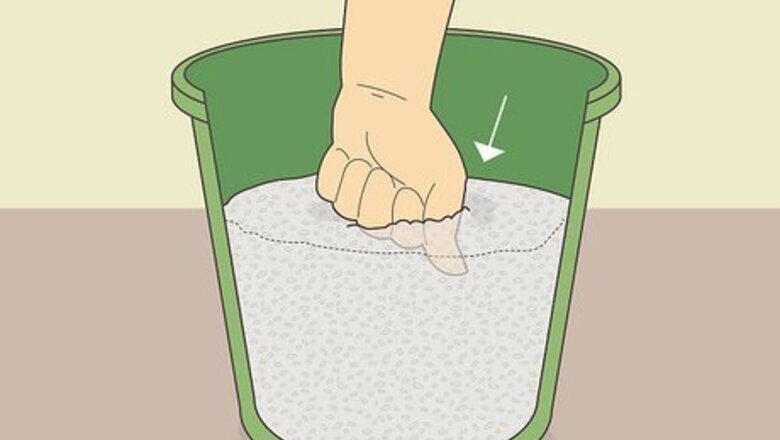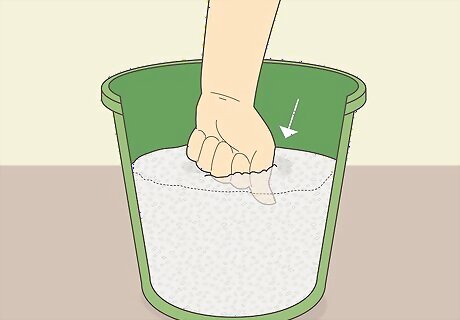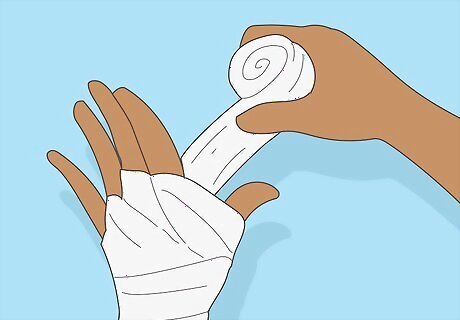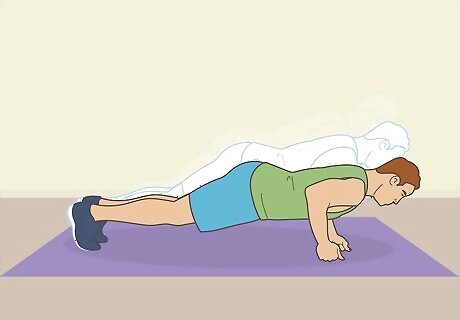
views
Punching Rice
Fill a bucket with raw rice. The bucket should be wider than your fist and deep enough to contain at least five inches of rice.
Grab the rice with your hands and twist your knuckles into it. Use a lot of force as you grip handfuls of rice, then release the rice back into the bucket. In addition, push your knuckles into the rice, and twist your hand to add additional pressure.
Punch your knuckles into the rice. Stop when you feel sore or if your skin breaks. Complete this exercise for a few minutes as part of your usual workout regimen, and use other knuckle conditioning methods in addition to punching rice for best results. Some martial artists replace rice with harder, more coarse material, but now, this is considered unsafe. Use rice unless you are training under the supervision of a professional trainer who recommends other materials.

Dig your thumbs deeply into the rice. Repeat this for every finger. Remember, the more contact your hands make with the rice and the more pressure you put on your hands, the better your results will be. Take a break if you are experiencing excruciating pain or begin to bleed.
Squeeze the rice as hard as possible, then release. Grab handfuls of the rice and squeeze. This will strengthen not only your knuckles, but your entire hand. Repeat the rice exercises as part of your regular workout.
Performing Hand-strengthening Exercises
Stretch your hands. Hold out your hands with your palms facing you. Individually bend the tips of your fingers towards your palm, and hold for 30-60 seconds. Bend each finger.
Incorporate a hand gripper into your usual exercise regimen. Overall hand strength will make your knuckles stronger as well. Buy a hand gripper if you do not already own one, and place it in your hand. Flex your fingers inward (towards your palm), and squeeze the two handles together until they touch. Repeat this five times for each hand. There are many shapes and models of hand grippers. Try multiple kinds to challenge your hands.
Hold a barbell tightly for 90 seconds. Take a barbell from its rack, and roll a small towel around it to prevent it from becoming sweaty and slipping out of your hands. Grip it tightly with both hands and hold for 90 seconds, then release it. Repeat this exercise three times.
Squeeze a rubber ball continuously for 90 seconds. You can use a tennis ball as well. Squeeze the ball tightly in your hand for 90 seconds, then let it go. Repeat this exercise three times per hand.
Tear apart a newspaper. Lay two pieces of newspaper on top of each other, then fold them in half. Tear the paper with both hands until the paper is in tiny pieces, and repeat this exercise until you have ripped up all of the newspaper.
Use a resistance band to strengthen hands. Grip a resistance band with one hand, your fingers and your palm facing up. The other end of the resistance band will go underneath your feet. You should be standing with your elbow at your side and bent to 90 degrees. Use the other hand to grip right below your wrist as you curl your wrist and fingers up against the resistance band. Perform 3 sets of 10 repetitions. Do this for both hands. This exercise will strengthen your wrists as well.
Using a Punching Bag

Wrap your hands. Use heavy-duty cotton wrist wraps to wrap your hands and prevent injury. Wraps will come with a loop that is placed around your thumb. Secure this loop around your thumb, then start wrapping the cloth around your wrist. Continue to wrap, moving the cloth upward until your entire hand and fingers are covered in 2-3 layers of secured cloth. Then, finish with one last wrap around your wrist. Secure the wrap with Velcro or by tucking the end of the wrap underneath the cloth on your wrist. Wrap both hands. Never use a punching bag without first wrapping your hands, even if you want to condition your knuckles.
Punch the bag without gloves. This increases the pressure on your hand bones and will allow your knuckles to become stronger. Remember to start off with only a few minutes of punching per day, then increase the time you punch the bag by a few minutes each week. If you normally use gloves when you're doing bag work, take them off for part of your workout to condition your knuckles.
Repeat as part of your normal workout to see results. Give your knuckles a break if they feel sore, and do not punch the bag without gloves until your knuckles are not sore to the touch anymore, which may take up to 2 weeks.
Doing Knuckle Pushups
Get in a standard pushup position. Make sure your back is straight and your feet are shoulder length apart. Complete knuckle pushups on a soft surface like carpet, a workout mat, or even grass. Over time, once these surfaces feel comfortable and are not challenging anymore, you can do knuckle pushups on a hard floor or concrete.
Place your weight on the first two knuckles of each hand. While still in the pushup position, make a fist with each hand one at a time, placing each fist on the floor. You will use your fists to hold up your body instead of your palms. Focus on placing your body weight mostly on the first two knuckles. You can also do fingertip pushups if knuckle pushups are easy for you. If you can do both knuckle and fingertip pushups, alternate between the two.

Perform the pushup by lowering your body, then pushing it back up. Lower your body until it almost touches the ground and push your body back up, using your knuckles to hold your weight the entire time. This may hurt at first and will irritate your knuckles, so only do 80% of the pushups you would normally do, and complete these on a soft surface. For example, if you usually do 100 pushups, only do 80, and if you do 80 pushups normally, only do 64. Increase the amount of knuckle pushups with each work out. If your knuckles are excessively sore, do not complete more knuckle pushups until they heal, up to 2 weeks.
Use your thumbs if you need stability. Place your thumbs on the ground to help stabilize your body if you are falling over or feel very wobbly.














Comments
0 comment